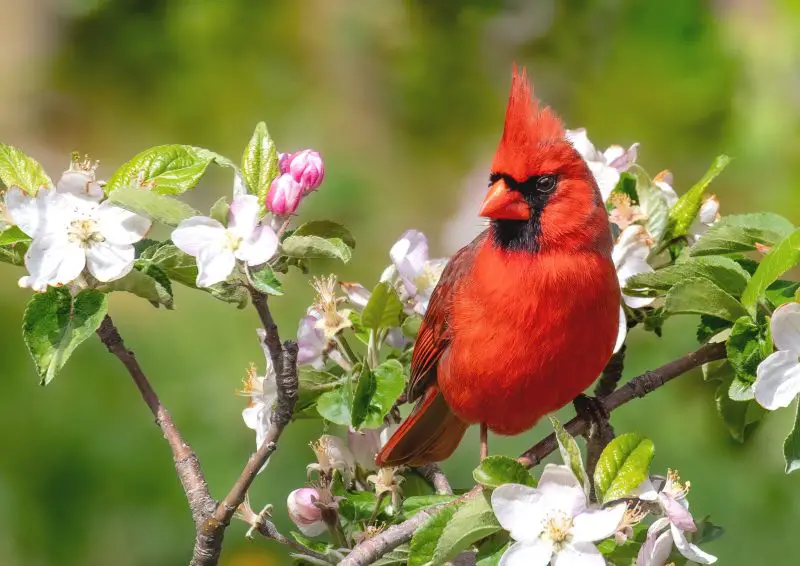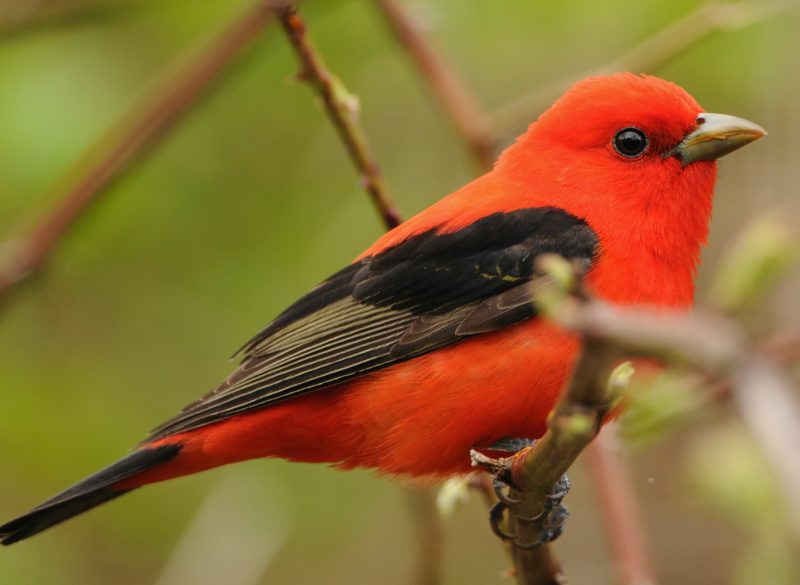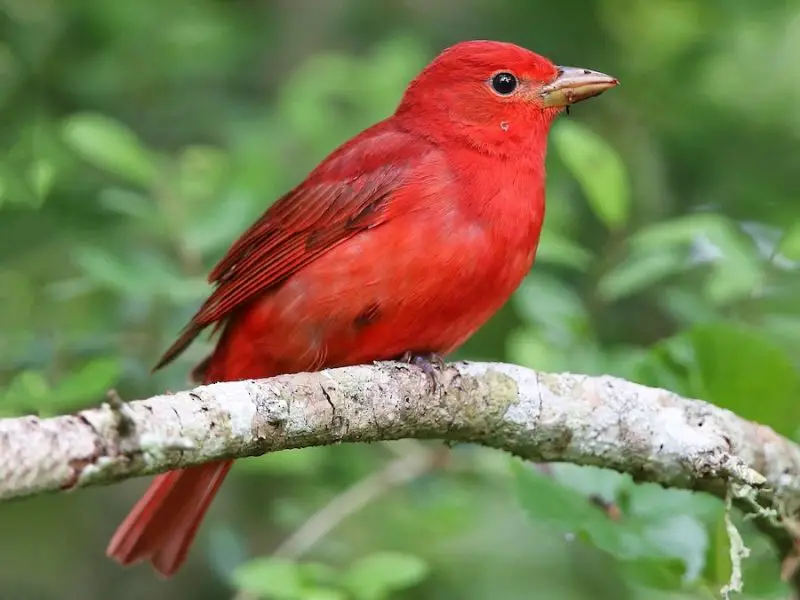New York is a state blessed with a wide variety of birdlife, from songbirds that fill suburban gardens with their cheerful calls to woodland species that thrive in the state’s diverse forests. Among the most admired are the cardinals and their close relatives, birds with striking red plumage that never fail to catch the eye of birdwatchers. The term “cardinal” most commonly refers to the Northern Cardinal, a year-round resident that has become a beloved backyard bird across the eastern United States. However, bird enthusiasts in New York may also encounter two other species belonging to the cardinal family (Cardinalidae), namely the Scarlet Tanager and the Summer Tanager.
It is important to clarify that the Northern Cardinal is the only true cardinal in New York, belonging to the genus Cardinalis. The Scarlet Tanager and Summer Tanager are not “cardinals” in the strict sense, but they are closely related and share similar traits, including vivid red coloration in the males. Because birdwatchers and casual nature lovers often group them together, this article will explore all three species, highlighting their characteristics, identification features, habitats, and seasonal appearances in New York.
By understanding the differences between these three birds, it becomes much easier to enjoy birdwatching in the state and to appreciate the rich diversity that the cardinal family contributes to New York’s natural heritage.
The Northern Cardinal in New York

Identification and Characteristics
The Northern Cardinal (Cardinalis cardinalis) is without question one of the most iconic birds in North America. The male is easily recognized by its brilliant crimson plumage, jet-black mask around the face, and a striking crest that gives it a regal appearance. Females are more subdued in their coloring, with warm brown feathers accented by hints of red on the wings, crest, and tail. Both sexes share a stout, cone-shaped orange bill perfectly designed for cracking seeds, which make up the bulk of their diet.
Northern Cardinals measure about 8 to 9 inches in length, with a wingspan ranging from 9.5 to 12 inches. Their presence is not just visual but also auditory. Their loud, clear whistles are common sounds in neighborhoods, woodlands, and parks. Unlike many songbirds, both male and female cardinals sing, often using songs to defend territories or to communicate between mates.
Habitat and Behavior
In New York, the Northern Cardinal thrives in a wide range of habitats. They are common in suburban gardens, city parks, forest edges, and shrubby thickets. Their adaptability has made them one of the few bird species whose population has expanded northward over the last century, aided by backyard bird feeders and warmer winters.
These cardinals are generally non-migratory, meaning they remain in New York year-round. This makes them especially cherished during the winter months, when their bright red plumage contrasts beautifully against snow-covered landscapes. Males are territorial and can often be observed defending their area, sometimes even attacking their own reflection in windows or mirrors, mistaking it for a rival.
Diet and Breeding
The diet of the Northern Cardinal is primarily composed of seeds, grains, and fruits, though they also feed on insects, particularly during the breeding season. Sunflower seeds are a favorite, which explains why they are frequent visitors to backyard feeders.
Breeding season begins in spring, and pairs are monogamous, often staying together throughout the year. The female builds a cup-shaped nest of twigs and grasses, typically hidden in dense shrubs. She lays three to four eggs, which hatch in about two weeks. During this period, males actively feed females and nestlings, ensuring the survival of the brood.
Significance in New York
The Northern Cardinal has become more than just a bird in New York; it is a symbol of beauty, resilience, and adaptation. Birdwatchers eagerly seek them out, while casual observers enjoy their bold presence in both rural and urban environments. As the only true cardinal in the state, it stands as the flagship species of this family for New Yorkers.
The Scarlet Tanager in New York

Identification and Characteristics
The Scarlet Tanager (Piranga olivacea) is a dazzling member of the cardinal family that visits New York during the warmer months. The male in breeding plumage is a breathtaking sight, with a vibrant scarlet body set off by contrasting jet-black wings and tail. Females and nonbreeding males, on the other hand, display more subtle olive-yellow tones, allowing them to blend into foliage.
Scarlet Tanagers are slightly smaller than Northern Cardinals, measuring about 6.5 to 7.5 inches long, with wingspans of 9.5 to 11.5 inches. Unlike the familiar whistles of the Northern Cardinal, the Scarlet Tanager’s song is more burry and raspy, often compared to a robin with a sore throat.
Habitat and Seasonal Presence
Unlike Northern Cardinals, Scarlet Tanagers are migratory, spending their winters in South America and returning to New York in late spring. They prefer large tracts of mature deciduous forests, particularly oak and beech woodlands, where they can forage high in the canopy. Because of their secretive habits, they are often heard before they are seen, hidden among dense foliage.
In New York, Scarlet Tanagers are most commonly spotted from May through September. During migration, they may also pass through urban parks and gardens, though their primary breeding grounds remain in deep forests.
Diet and Breeding
The diet of Scarlet Tanagers consists mainly of insects such as beetles, caterpillars, ants, and wasps, though they also consume berries and fruits later in the summer. Their insect-eating habits make them an important part of the forest ecosystem, helping to regulate insect populations.
Nesting takes place high in trees, where females build loosely constructed nests on horizontal branches. Clutches typically contain three to five eggs, and the female incubates them for about two weeks. Both parents participate in feeding the nestlings, which fledge within 10 to 12 days.
Importance in New York Birdlife
The presence of Scarlet Tanagers in New York is a sign of healthy forest habitats. Although less familiar than the Northern Cardinal, their striking appearance and seasonal visits make them a prized sight for birdwatchers. Protecting forested landscapes is essential for maintaining their populations in the state.
The Summer Tanager in New York

Identification and Characteristics
The Summer Tanager (Piranga rubra) is another member of the cardinal family, though it is far less common in New York than either the Northern Cardinal or the Scarlet Tanager. Males are uniformly bright red, lacking the contrasting black wings that distinguish the Scarlet Tanager. Females and immature males are yellow to orange-yellow, creating a sharp difference between the sexes.
Summer Tanagers are similar in size to Scarlet Tanagers, averaging 6.7 inches in length with wingspans of 11 to 12 inches. Their song resembles that of a robin but is smoother and more melodious, often described as a series of whistled phrases.
Habitat and Rarity in New York
In general, Summer Tanagers are birds of the southern and central United States, where they breed in open woodlands and pine-oak habitats. Their main range does not extend into New York, but occasional individuals are recorded during spring or fall migration, making them rare visitors to the state.
When they do appear in New York, sightings are usually brief and localized, often generating excitement among birdwatchers. Their presence is not consistent enough to consider them a regular part of the state’s avifauna, but they remain part of the cardinal family and thus deserve mention.
Diet and Behavior
Summer Tanagers have a specialized diet that sets them apart. They are sometimes called the “bee bird” because of their preference for wasps and bees. They skillfully catch these insects in midair, then remove the stingers by rubbing them against a branch before eating them. This behavior makes them valuable predators in their native habitats, helping control populations of stinging insects.
In addition to bees and wasps, they also consume other insects and fruits, especially during migration. Their bright plumage and unique feeding habits make them a fascinating species, even if they are rare in New York.
Significance of Sightings
For birdwatchers in New York, spotting a Summer Tanager is considered a special event. Their rarity adds to the excitement, and many birders keep records of unusual visitors. Although they are not a regular part of the state’s bird population, their occasional presence demonstrates the migratory connections between northern and southern bird populations.
Clarifying the True Cardinal in New York
While bird enthusiasts may refer to three “types of cardinals” in New York, it is crucial to emphasize that only the Northern Cardinal is a true cardinal. The Scarlet Tanager and Summer Tanager are related species in the same family (Cardinalidae), but they belong to the genus Piranga rather than Cardinalis. Their inclusion in this article reflects their close family ties and the common confusion that arises when people see multiple bright red birds in the state.
Understanding this distinction enriches birdwatching in New York. Recognizing that the Northern Cardinal is the resident species, while Scarlet Tanagers are regular migrants and Summer Tanagers are rare visitors, allows birders to properly identify and appreciate each bird in its own right.
Conclusion
New York offers a fascinating glimpse into the cardinal family, with three species appearing in different ways across the state. The Northern Cardinal is a year-round resident, beloved for its bright plumage and cheerful songs. The Scarlet Tanager brings a seasonal burst of color to New York’s forests each summer, while the Summer Tanager makes rare but memorable appearances during migration.
By learning the distinctions between these three species, birdwatchers can deepen their appreciation of New York’s avian diversity. And by protecting natural habitats, from suburban gardens to mature forests, the state ensures that these birds will continue to thrive for generations to come.
FAQs about Cardinals in New York
Are there more than one type of cardinal in New York?
Technically, New York has only one true cardinal species, the Northern Cardinal. However, two close relatives in the cardinal family, the Scarlet Tanager and the Summer Tanager, also appear in the state.
Do Northern Cardinals live in New York year-round?
Yes. Northern Cardinals are non-migratory birds and can be found in New York throughout the year, including the winter months when their bright red plumage is especially striking against the snow.
When can I see Scarlet Tanagers in New York?
Scarlet Tanagers typically arrive in New York in May and remain through late summer. They breed in mature forests and are most commonly seen from May to September before migrating south to South America for the winter.
How rare is the Summer Tanager in New York?
The Summer Tanager is a very rare visitor to New York. Most sightings occur during migration in spring or fall, and they are not a regular part of the state’s bird population.
How can I attract Northern Cardinals to my backyard?
Northern Cardinals are easily attracted to backyards with bird feeders stocked with sunflower seeds, safflower seeds, and fruit. Dense shrubs and trees also provide nesting areas and cover, encouraging them to stay year-round.






